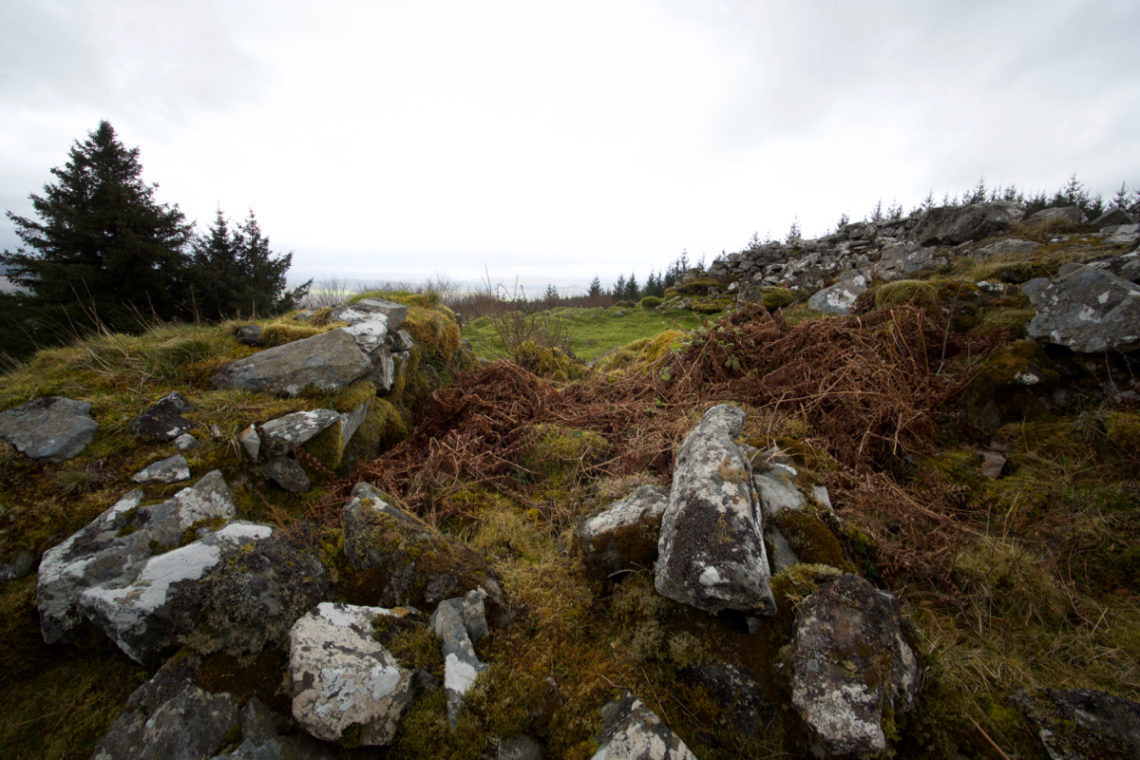
Torinturk and the fort of the black dog
“This is the weather the cuckoo likes,
And so do I;
When showers betumble the chestnut spikes,
And nestlings fly…”
from ‘Weathers’ (1922) by Thomas Hardy
We’re getting exactly this kind of weather at the moment – heavy squalls blowing over on a cold wind, and I feel sorry for the baby birds. The horse chestnuts are in full flower, their big showy spikes standing upright like candles above the massive umbrella-like leaves. After the showers have passed, it seems as if the trees continue to rain for an hour or more, as all the water drips off the foliage.
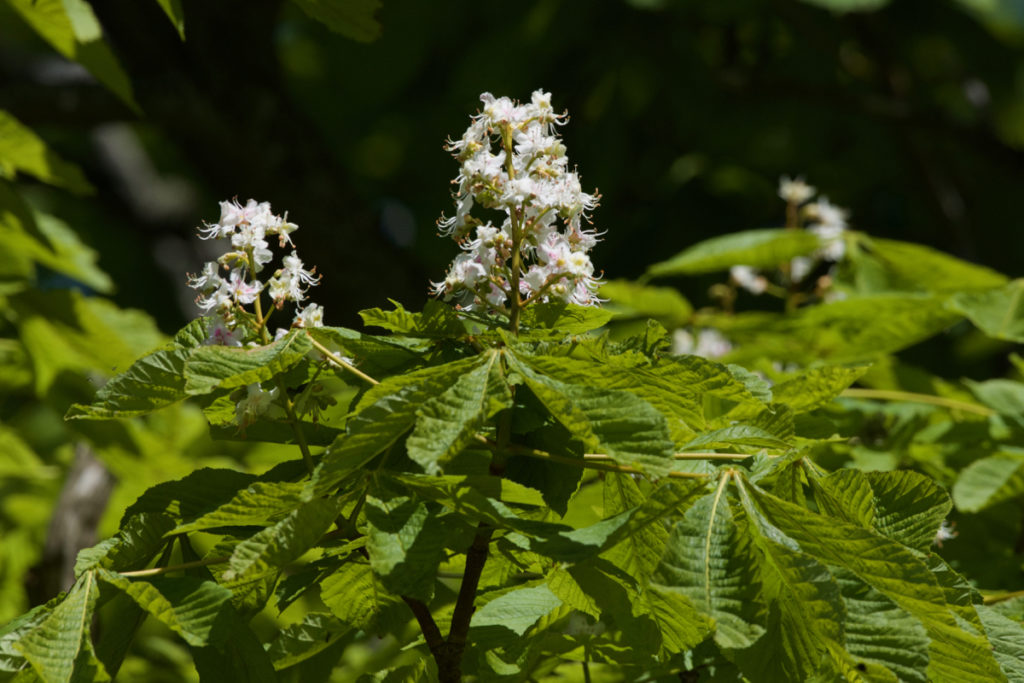
We’ve heard the cuckoo several times, in different places: here in Lunga, down at Ballachuan hazel wood, and in Scammadale, where it was calling loudly from high on a hillside of birch and willow. A second bird was calling way across the loch, creating the illusion of an echo.
The sycamores have been quite literally humming with bees, as they feast on the pollen of the dangling flowers. They are still busy long after sunset, when the bats are coming out and the first tawnies are starting to call. I wonder where they all go to sleep.
In the middle of April we took a walk through the woods above Torinturk in Knapdale. The wild cherry was just coming out, there were celandines and primroses in the grass, and somewhere in the trees a warbler was singing. The path climbed up through stands of conifers, mixed with birch, ash and hazel. The leaves hadn’t yet come out, and raindrops sparkled on the lichen that hung from the branches.
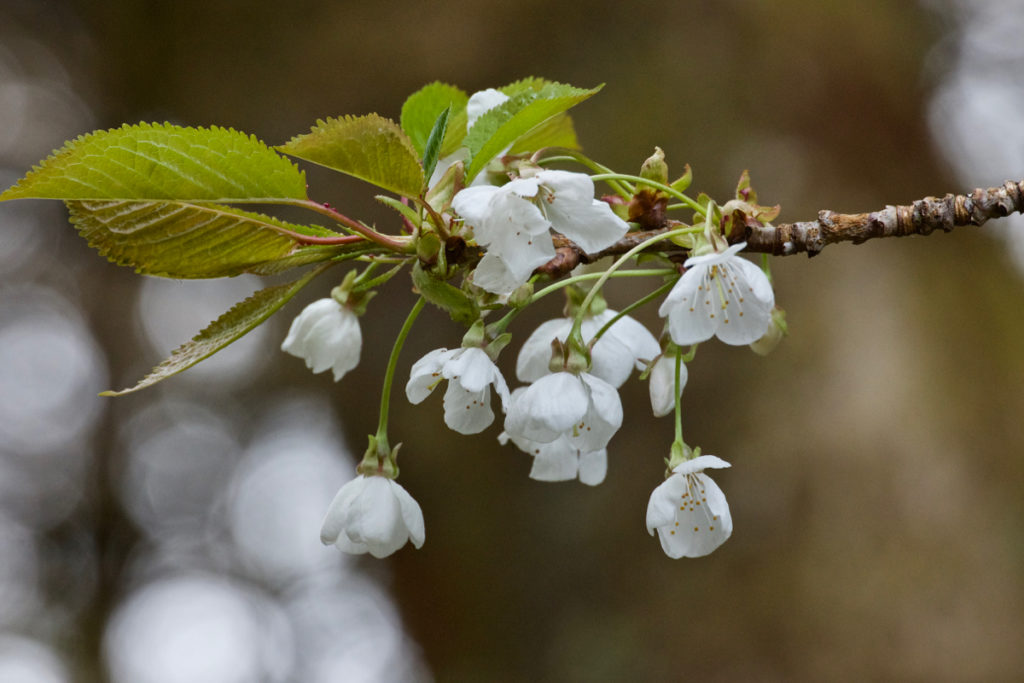
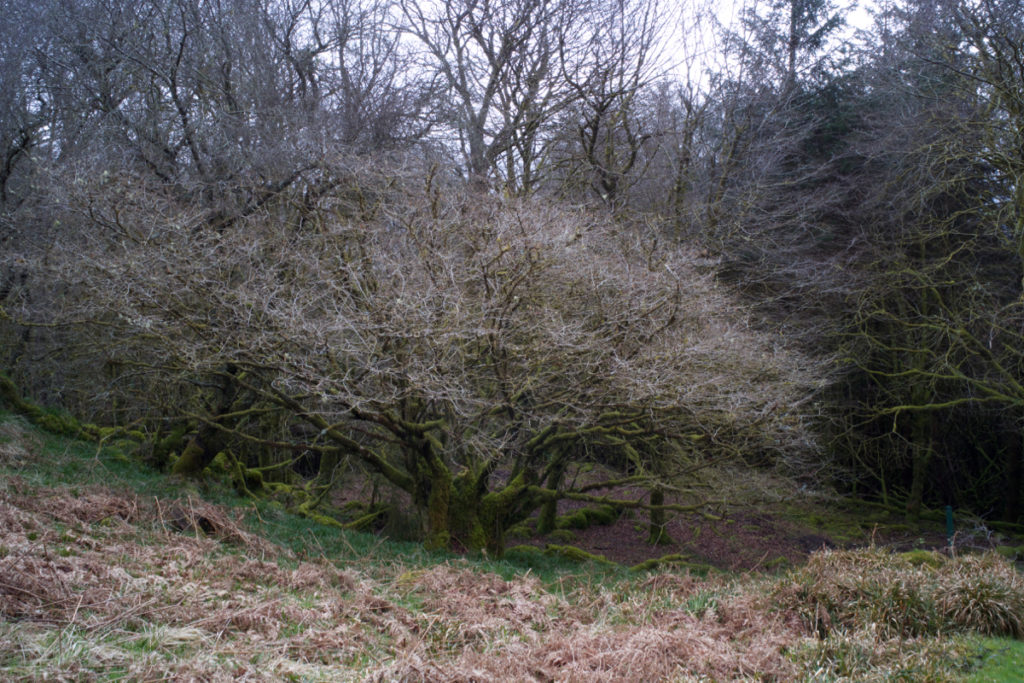
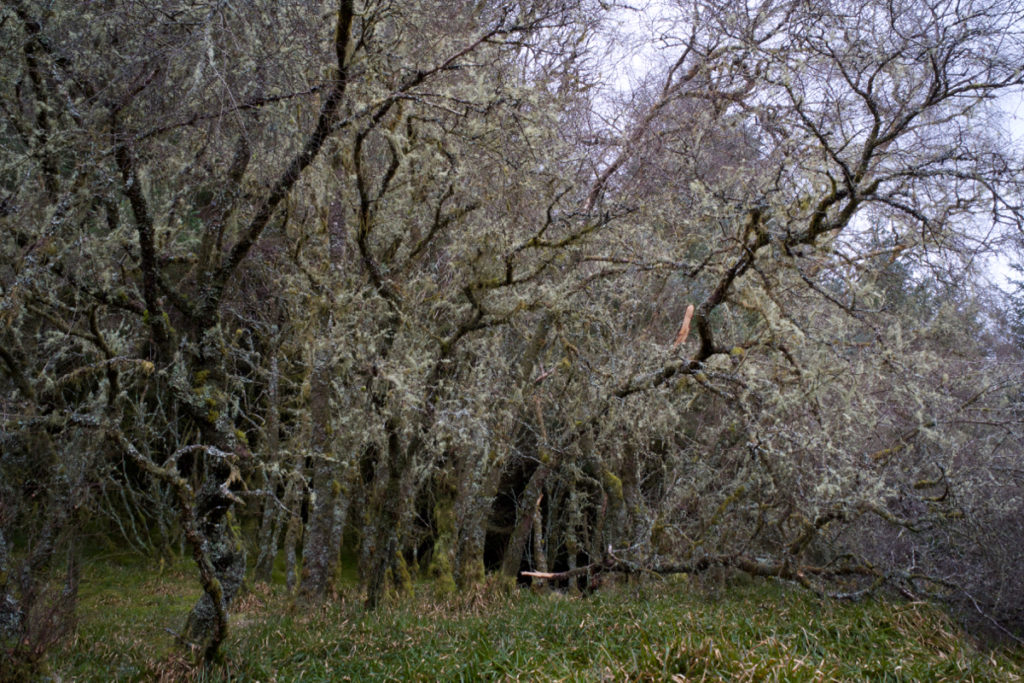
After about half an hour we came to a clearing. At the far side rose a large rubble-strewn cairn, while to the left a low, elongated mound was marked at each end by standing stones. Other boulders were scattered around, but it was hard to tell if they were randomly placed or if they had some ancient significance.
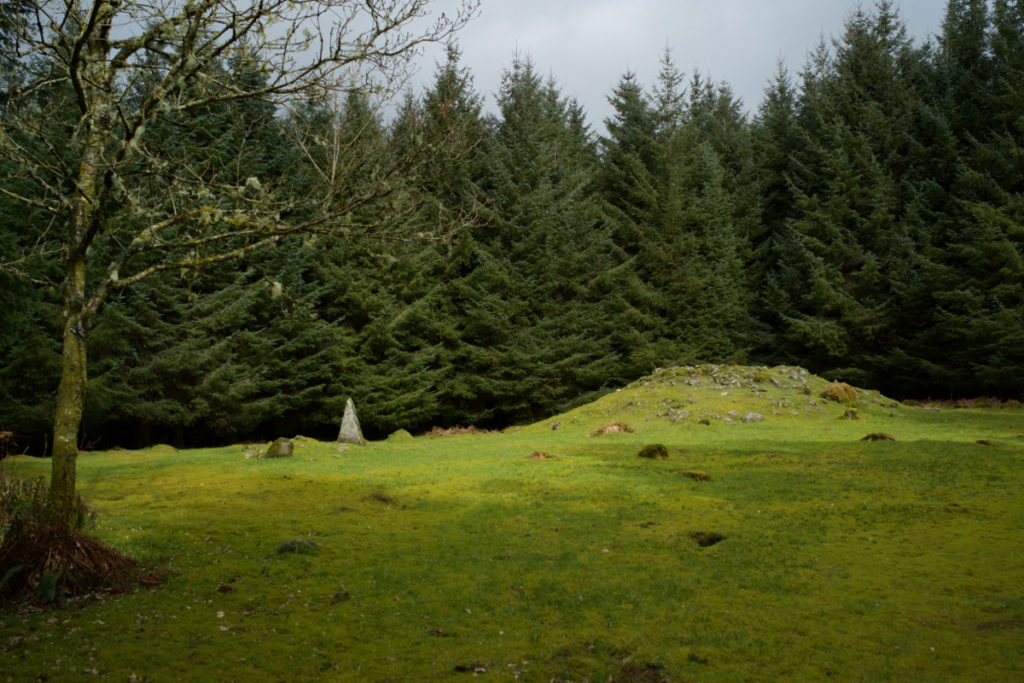
Canmore’s database doesn’t offer a date for the cairn; the survey reports (between 1964 and 1986) describe trees and bracken growing on it, and on several visits it was covered with branches of lopped timber, making it hard to examine the site properly. There’s a note that the slightly hollowed-out summit may be the work of treasure-seekers.
Meanwhile the smaller mound has a more interesting story. Locally it’s called the Giant’s Grave or Diarmuid’s Grave. The name Diarmuid suggests a connection with the old Irish legend of Diarmuid and Grainne, and I’ve come across it before at Strontoiller in Glen Lonan. It’s a beautiful, melancholy story, where you feel as if you know the ending almost before it has begun. I won’t repeat it here, but you can read it in this blog post.
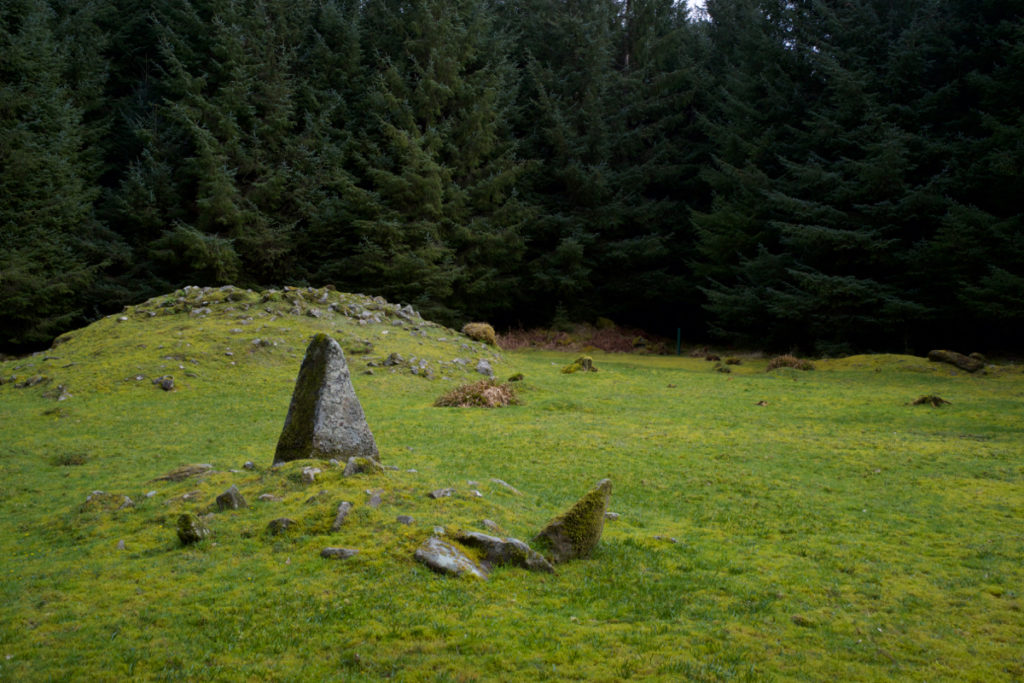
Every now and then there was a rush of wind through the tops of the tall conifers, sounding so much like breaking waves that I looked up instinctively every time it happened. But the clearing itself was quite still – so much so that a peacock butterfly floated around and then rested a while on top of the cairn in the sunshine.
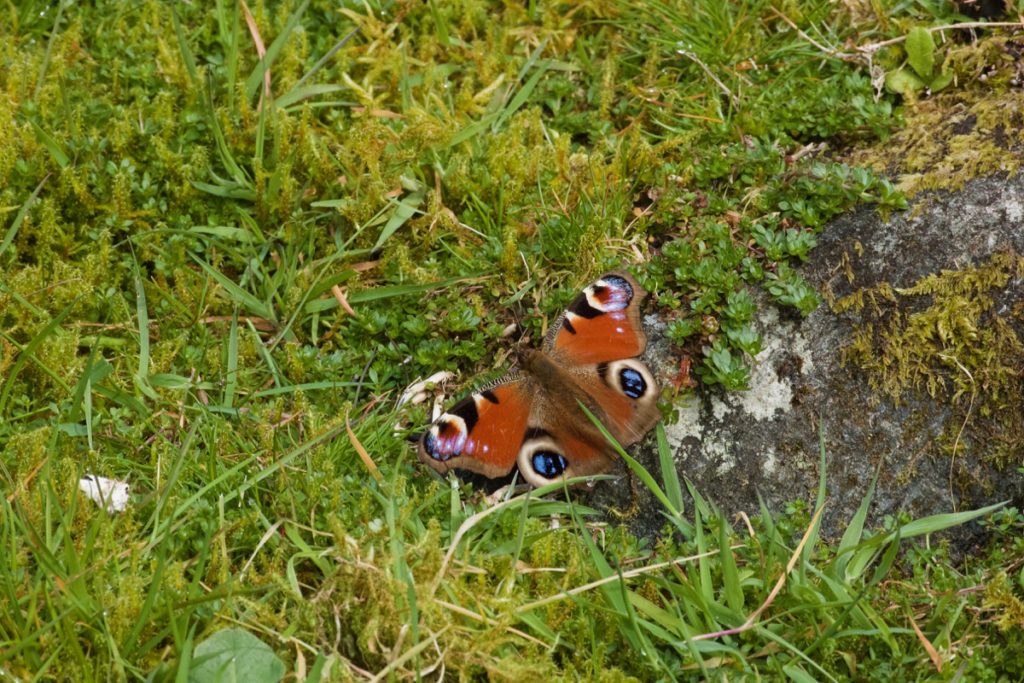
Rejoining the path, we followed a signpost pointing up through the woods to Dun a’ Choin Duibh, ‘the fort of the black dog’. The last stretch, up the steep side of the hill fort, was a slippery scramble and I wasn’t expecting much more than a few half-buried boulders, so I was astonished to see the remains of thick circular walls rising to several courses above ground level.
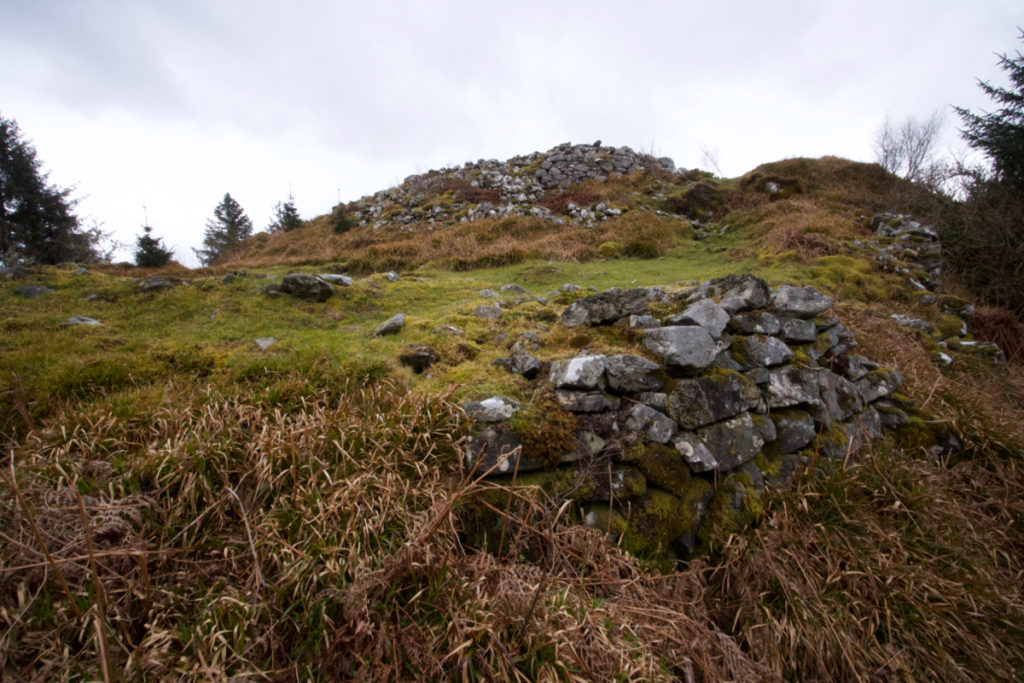
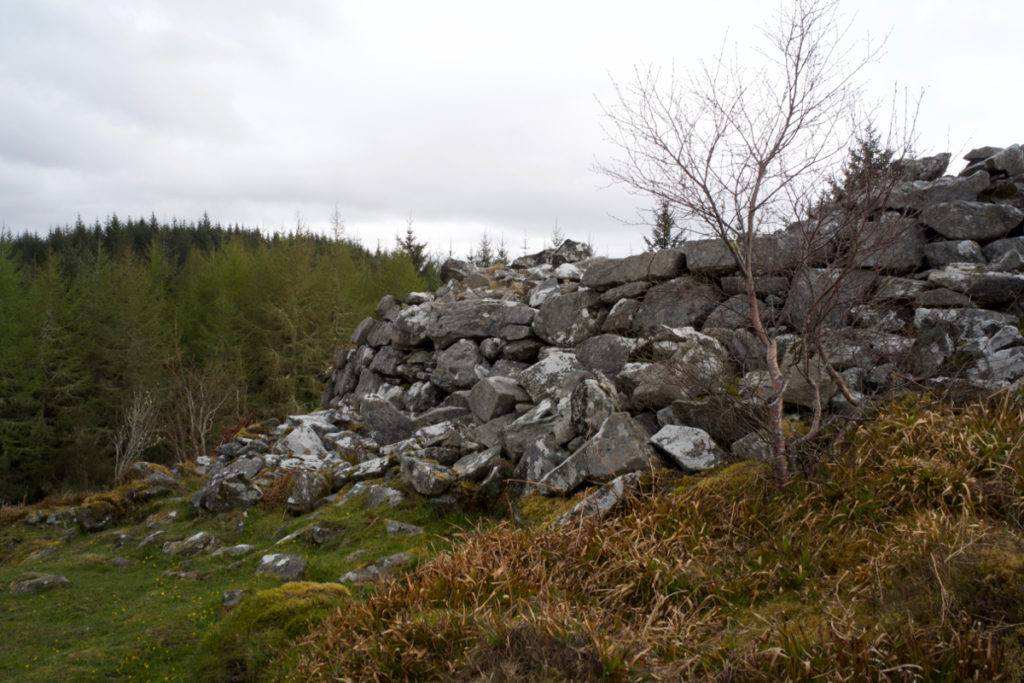

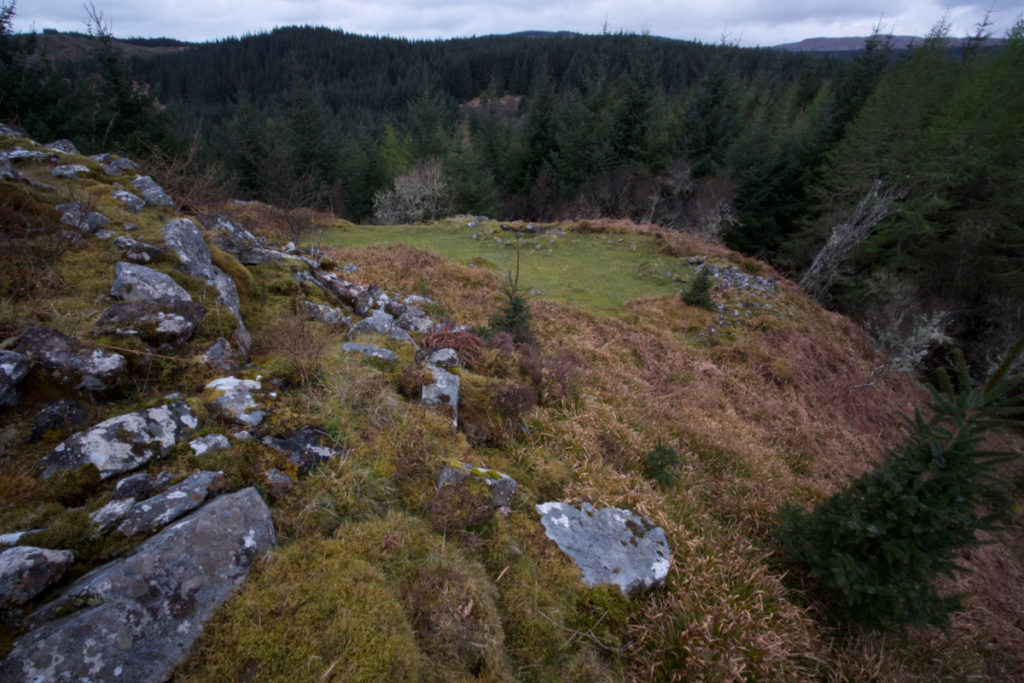
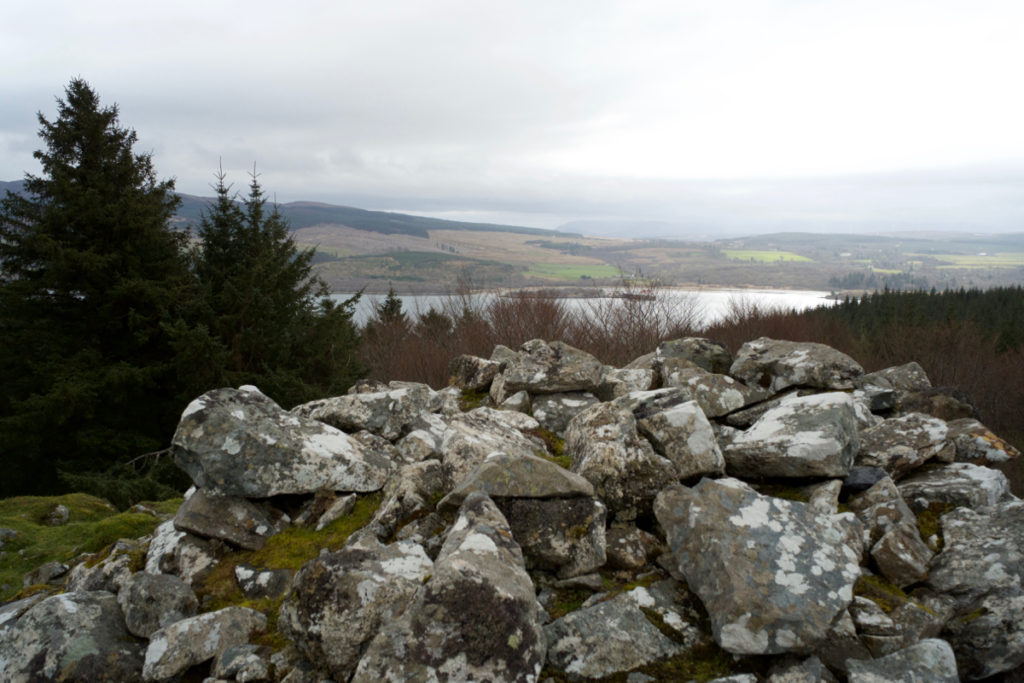
There seemed to be an outer encircling wall, and the dun stood within it; walking all round, we could make out what looked like an entrance. The views from the top were stunning, looking out across West Loch Tarbert, where the Islay ferry was just coming in, and down towards Kintyre.
In the dun’s wall was an opening a few feet high, and Colin shone a torch inside. It appeared to lead to an internal chamber, and it looked dark, damp and claustrophobic, with cobwebs stretching from side to side. However, I genuinely couldn’t imagine writing a blog post with the words “I didn’t feel like going in,” so I crawled down the short passage to see what was at the end.
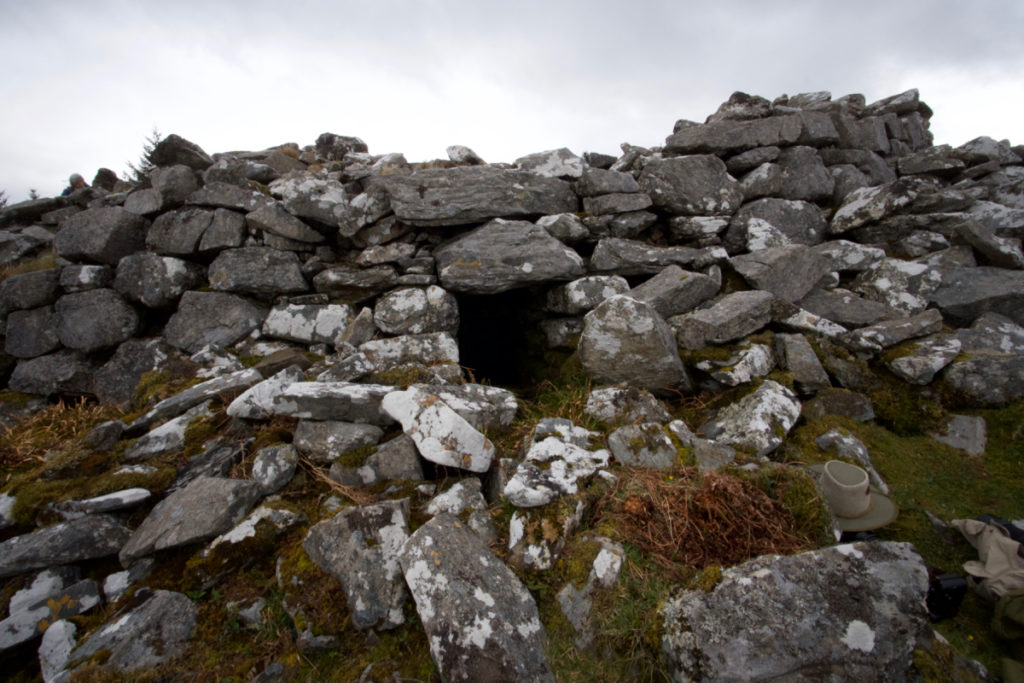
After a couple of yards the tunnel turned to the right and ended abruptly in a confined hollow that was lined with smaller pebbles; I don’t know if this is an original feature, or the result of subsidence. Canmore suggests that this passage might have been a type of postern (secondary entrance), and describes it as being partly lintelled and partly corbelled.
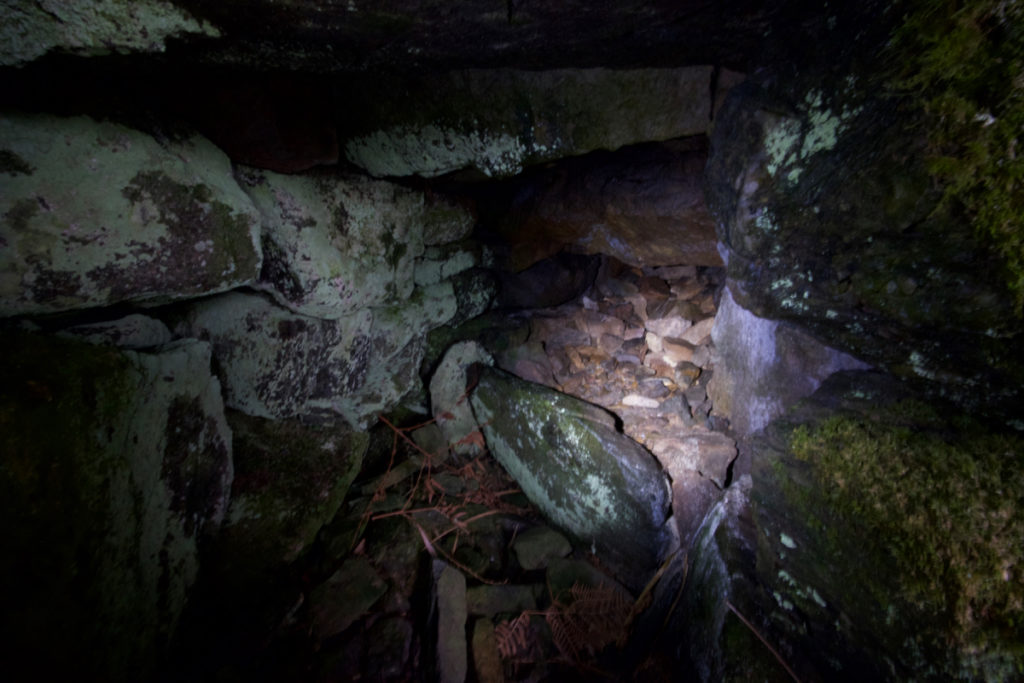
The stones were clammy with moisture and I crawled out backwards with more haste than dignity. Colin went in to take some photos, and came out saying something about ‘cave spiders’. I remembered the cobwebs, and then I had to shake my hair and my coat just to get rid of the thought. It was OK for Colin, because he was wearing his Indiana Jones hat.
With a name like ‘the fort of the black dog’, you’d expect a dark story to be attached to this place, and you’d be right. Local tradition says that a black hound which was half-wolf once lived here. But there’s a longer tale, involving the legendary hero Fionn Mac Cumhaill and his famous hound, Bran…
Fionn and his band of warriors, the Fianna, had spent a day hunting with their dogs and had camped out in the open. Next morning, Fionn rose early and saw a strange man walking towards him, wrapped in a red cloak and leading a black dog.
The stranger turned out to be Eubhan Oisein, the Prince of Innis Torc, and his dog, named Foir, was the brother of Fionn’s dog, Bran; the two had been separated as pups and meanwhile both had grown into fearsome hunters. The Prince wanted a dog fight to see which hound was the strongest (why couldn’t they just have had races, or something?) and so a contest was arranged.
With all the men of the Fianna looking on, Fionn unleashed fifty of his own dogs one after another, but Foir killed them all. Another fifty, and then another, were unleashed, and all went the same way. Fionn’s glance alighted on his faithful hound, Bran, who knew what was next: his eyes flashed with fire, and he leaped forward on his golden chain. Snarling, Bran and Foir were placed nose to nose and then set free; the fight lasted from morning to evening (these were the dogs of warrior-gods after all), but in the end Bran was the victor.
Sadly, the Prince buried his beloved Foir where he fell, at Dun a’Choin Duibh, and the Fianna buried their dogs close by.
In a long traditional poem, the Prince laments his loss:
There is many a fair and pretty maiden,
Of bluest eye and golden hair,
In the country of the son of King Torc,
Who would give food to my dog to-night.
Then the true, generous hero
Buried his dog in a narrow clay bed,
And the Fayn also buried
In the mound westward three fifty dogs.
Eibhinn Oisean departed from us,
Regretting that he had ever come,
For he lost his good dog,
Which was of great intelligence, vigour, and strength.
The entire poem, translated by the Rev D MacInnes and eulogising the properties of both dogs, can be read in Archibald Campbell’s ‘Waifs and Strays of Celtic Tradition’ (1899).
Another version of the story says that the event took place about 30 miles north of Torinturk. At the top end of the Craignish peninsula (which is where we live), there is a flat, raised field called Lergychoniemor which Archibald Campbell translates as ‘the plateau of meeting’. A nearby dun is called Caisteal nan Coin Dubh, the castle of the black dogs.
It really just goes to confirm what I often think about this amazing landscape in which we live: pretty much every hillside and boulder has a story attached to it. Hill forts are generally exposed and bracing places to visit, but a week or so ago we made a pilgrimage into the gentler, more welcoming hazel woods of Ballachuan, where the bluebells were out and the atmosphere was one of scented bliss. The hazel leaves were just emerging and in places the petals of cherry blossom littered the ground like confetti. It’s a place where you walk quietly and breathe deeply.
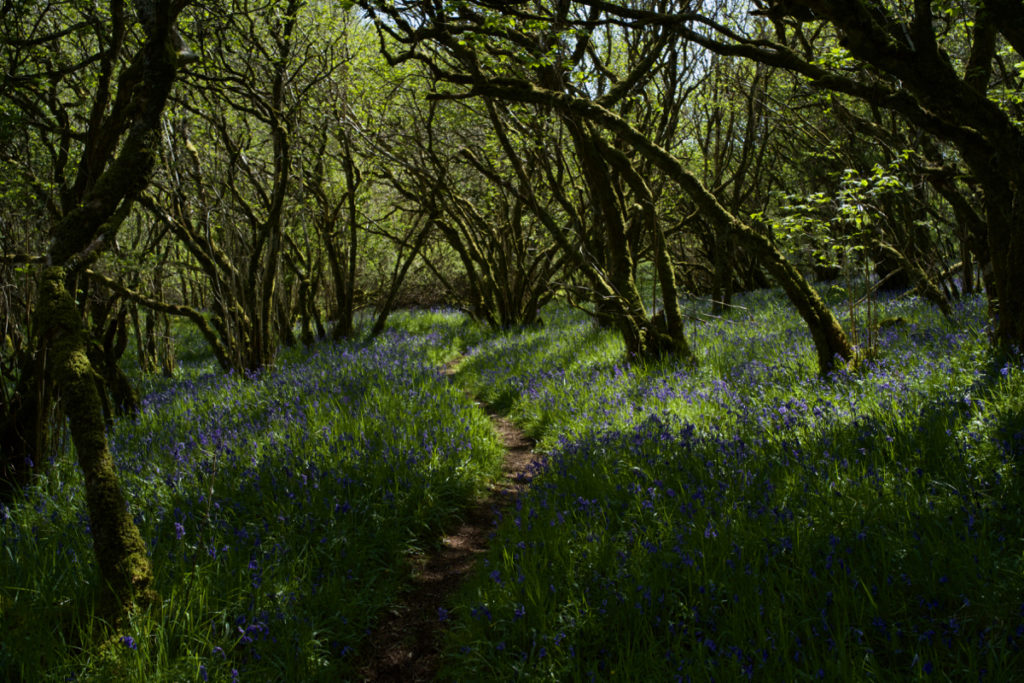
Reference:
- Canmore (cairn)
- Canmore (Giant’s Grave)
- Canmore (Dun a’Choin Duibh)
- Forest and Land Scotland
- Walkhighlands
- Archibald Campbell, Waifs and Strays of Celtic Tradition (1899)
Images copyright Colin & Jo Woolf



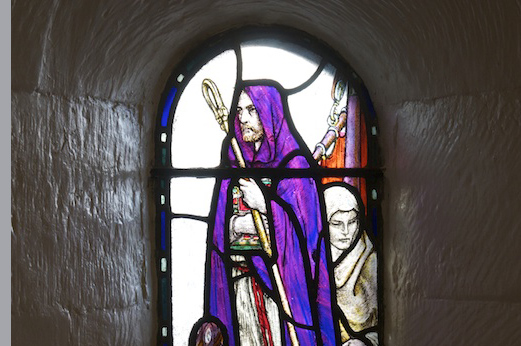
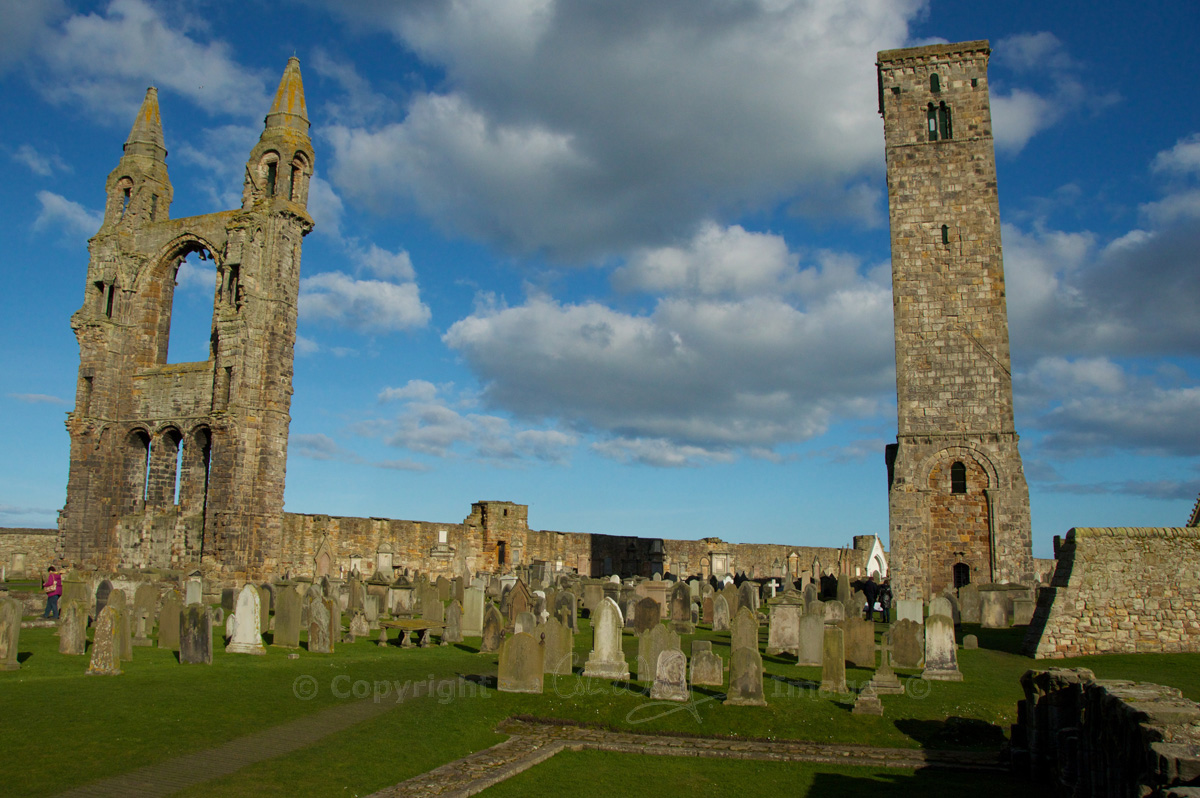
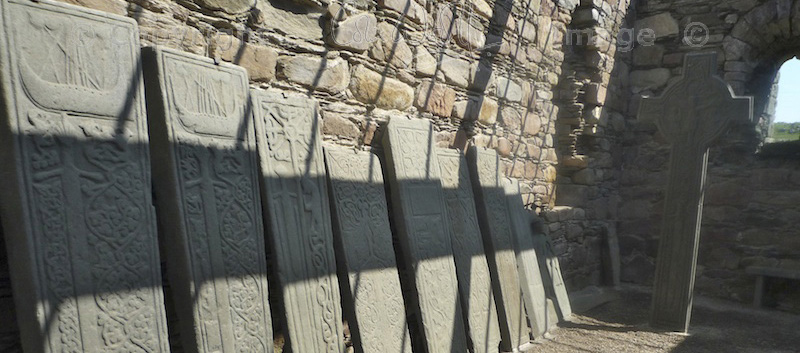
10 Comments
jlowstuter
Enchanting! You’re very brave to go crawling around inside of that cave, but I suppose it’s hard to resist when you’re standing in front of the door!
Jo Woolf
Haha, thank you! Well I knew it was now or never! I didn’t appreciate until I saw the pics how well it is constructed.
Bob Hay.
Great that these old stories were recorded Jo.
Re that peacock butterfly. When I went to the Kilneuair Chapel site years ago I filmed one of them on some flowers. Never did know their name till you mentioned it. Are they native to that area?
Jo Woolf
I know, we’re indebted to people like Archibald Campbell who managed to write down these stories from the ‘old folks’ before they were forgotten. Yes, peacocks are native and found pretty much across the whole of Britain as far as I know – the caterpillar feeds on nettles. They’re incredibly beautiful! They seem to be doing well this year.
davidoakesimages
another good read….. I have bookmarked it so I can read again and digest at leisure. As for the weather…… you can tell the cuckoo he is welcome to it., 🙂
Jo Woolf
Haha! 😀 😀 I’ll tell him! Thank you, David!
Finola
Wonderful post – but really, you must get your own Indian Jones hat.
Jo Woolf
Haha, thanks Finola! I know, sounds like a good idea but I’d never wear it! 😀
Cathy Donnelly
I so enjoy your blogs. They take me to another world. Thank you.
Jo Woolf
Aw, thank you Cathy! That’s so nice to know! 🙂